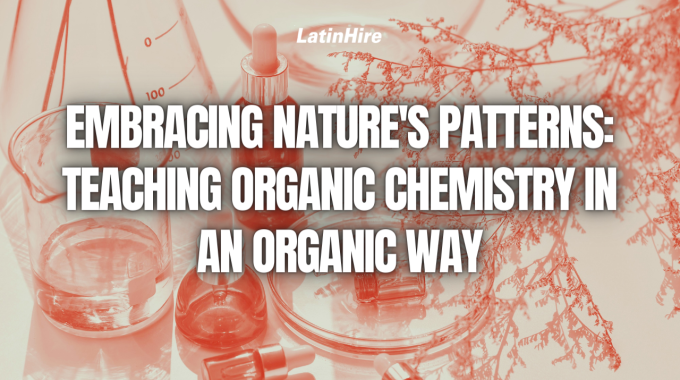Much of what we come across day to day involve chemical reactions, from the food…

Embracing Nature’s Patterns: Teaching Organic Chemistry in an Organic Way
Organic chemistry is the study of carbon-based compounds and forms the backbone of life itself. It is a subject that can be both fascinating and challenging for students due to the complexity of organic molecules and their versatility of reactions.
By adopting an “organic” approach to teaching this subject, educators not only enhance their students’ understanding but also inspire a deeper appreciation for the interconnectedness of nature.
In this article, we will explore seven strategies and principles for teaching organic chemistry in an organic way.
1) Cultivate a connection with nature

Organic chemistry is inherently linked to the natural world. Begin by emphasizing this connection and the significance of carbon-based compounds in living organisms.
Encourage students to explore the world around them, noting organic molecules they encounter daily, such as sugars, fats, and proteins. Engage students in discussions on how these compounds contribute to the functionality of living systems.
2) Promote inquiry-based learning
One of the most effective ways to teach organic chemistry in an organic way is through inquiry-based learning. Encourage students to ask questions, make observations, and develop hypotheses about the behavior of organic compounds.
Provide them with opportunities to design and conduct experiments, allowing them to explore the properties and reactions of different organic molecules firsthand. This approach fosters critical thinking, problem-solving skills, and a deeper understanding of organic chemistry principles.
3) Real-world applications

Highlighting the practical applications of organic chemistry can enhance student engagement. Showcase how organic compounds are utilized in various fields such as medicine, agriculture, environmental science and materials science.
Discuss the development of pharmaceutical drugs, sustainable farming practices, or the creation of biofuels. By connecting organic chemistry to real-world scenarios, students can grasp the relevance and potential impact of their learning.
4) Visualization and model building
Organic chemistry involves understanding complex molecular structures and their spatial arrangements. Encourage students to visualize organic compounds and their reactions by utilizing models, both physical and digital.
Molecular model kits, computer software, or interactive online resources can aid in comprehending 3D structures and provide a tangible representation of organic molecules. This visual approach helps students develop spatial reasoning skills and facilitates a deeper grasp of organic chemistry concepts.
5) Sustainability and green chemistry

Emphasize the principles of sustainability and green chemistry throughout the organic chemistry curriculum. Highlight the importance of designing chemical processes and reactions that are environmentally friendly, minimize waste, and reduce the use of hazardous materials.
Discuss innovations in sustainable chemistry, such as the development of biodegradable plastics or the use of renewable resources as starting materials. By promoting these concepts, students develop a sense of responsibility towards the environment and learn to apply organic chemistry knowledge for a sustainable future.
6) Integrating multidisciplinary approaches
Organic chemistry intersects with various scientific disciplines. Encourage collaboration and integration of knowledge from other fields such as biology, biochemistry, environmental science, and pharmacology.
Explore interdisciplinary topics like the role of organic compounds in drug discovery, the impact of organic pollutants on ecosystems, or the molecular mechanisms underlying biological processes. By incorporating multidisciplinary approaches, students gain a broader perspective on the interconnectedness of scientific disciplines.
7) Incorporating indigenous knowledge and traditional medicine

Explore the rich heritage of indigenous cultures and their traditional knowledge of organic compounds and medicinal plants. Introduce students to the principles and practices of traditional medicine, herbal remedies, and ethnobotany.
Discuss how different cultures have harnessed organic chemistry principles in their healing traditions. This approach fosters cultural appreciation, opens doors for cross-cultural dialogue, and broadens students’ understanding of the diverse applications of organic compounds.
We hope you found this article helpful and interesting as a chemistry tutor. How do you tackle the topic of organic chemistry in your classes? Share your ideas in the comments section below!



